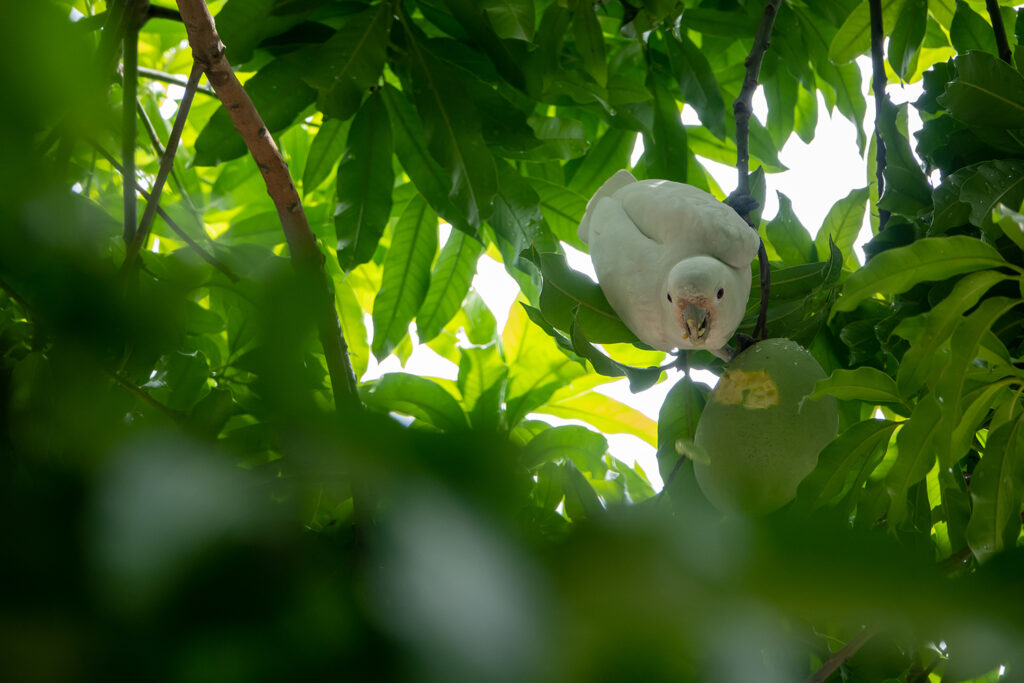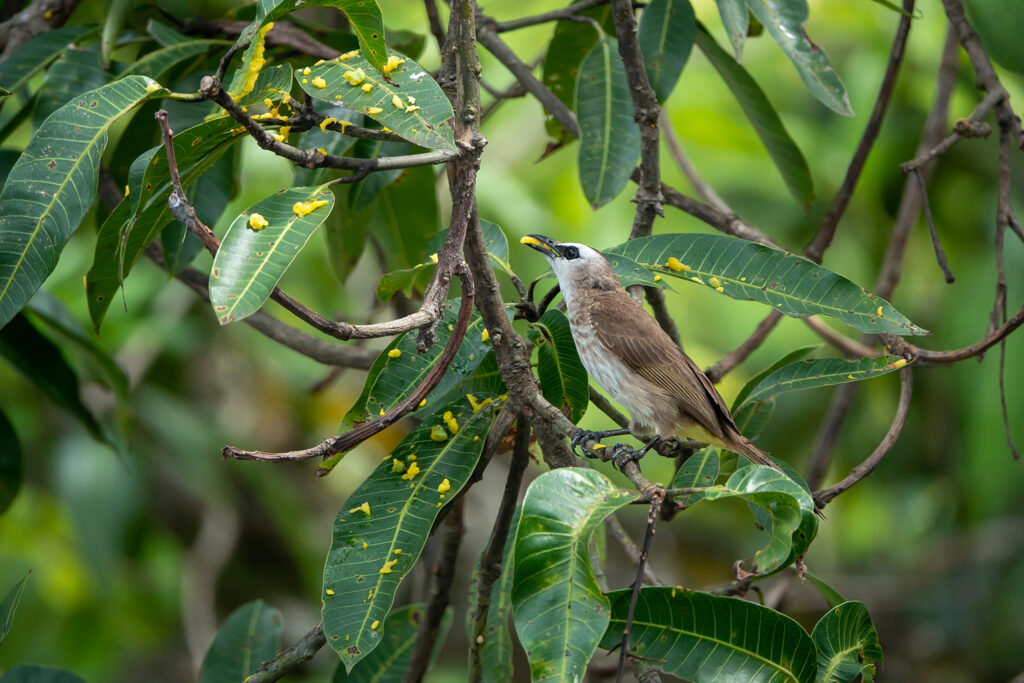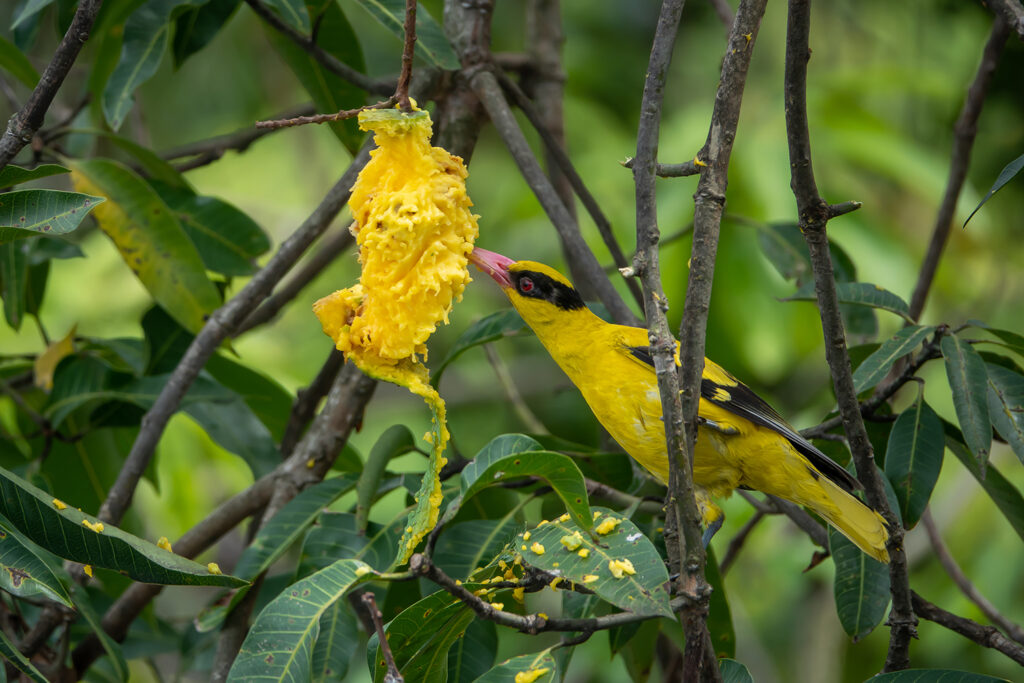Regardless of where you come from, you’re missing out on the Singaporean experience if have you never queued long long for food before. And it seems that our locally found parrots know that too! Here are some intriguing observations on the feeding behaviour of three parrot species – Tanimbar Corella, Coconut Lorikeet and Blue-crowned Hanging Parrot.
By Muhammad Nasry
Earlier this year, an alert that a stretch of mango trees around the Alexandra Village area was fruiting and attracting Coconut Lorikeet Trichoglossus haematodus began circulating online, featuring eye-level shots of this colourful parrot happily munching away at the fruit. Naturally, this attracted a whole horde of birders, myself included. Having lived near the area since birth but blithely unaware of the existence of these mango trees, I was a little embarrassed for not realising sooner, but excited by the discovery of a new birding spot just minutes from my doorstep.
And so I visited. Again. And again. And again.
Over the course of several visits I began to notice an odd pattern in terms of the foraging behaviour of some of the birds there. Consistently, this feeding pattern repeated itself over and over.
The first to arrive was usually the Tanimbar Corellas Cacatua goffiniana. These parrots seemed to prefer feeding on the outermost bits of the mango fruit, only occasionally reaching deeper into the mango for more of the pulp.

Second on the scene was typically the star attraction: the Coconut Lorikeets. They would pick up where the corellas had left off, peeling off what remained of the fruit skin. They would then proceed to rip apart the rest of the fruit (as parrots do) while eating, with the bits of fruit either being scattered on the surrounding foliage or dropping straight to the ground.

The lorikeets were often seen foraging in pairs, with the occasional dispute breaking out between pairs over mangoes. There were up to three pairs seen at the same area at any one time. In one instance, one of the pair was feeding while the other stood guard, screaming its head off to ward off any would-be usurpers of the coveted mangoes.
Only after the lorikeets left would the Blue-crowned Hanging Parrots Loriculus galgulus move in on the fruits. A male and female were both seen feeding here, but never at the same time.

This feeding order was generally consistent – each parrot species usually came to feed only after the previous one had left. Competition due to size differences may explain this pecking order (pardon the pun), given that the corellas are the largest, and hanging parrots the smallest. The issue with this theory is that there were plenty of mangoes to go around, many of them a similar shade of green as the ones being eaten (which presumably indicates they were equally edible) and therefore competition was not necessary. However, the hanging parrots seemed to pass up these seemingly fine mangoes in favour of those that had already been opened by the two introduced parrot species. Perhaps letting the bigger parrots do the hard work of opening up the unripe mangoes may be more convenient for them – they may have to use a lot more effort with their comparatively smaller beaks to open up the mangoes on their own.
The messy eating habits of the parrots did not go unnoticed by other animals; there were intermittent visits to the mangoes (or to the bits of mango strewn around on the branches) by other common urban species, which included:
- Olive-backed Sunbird Cinnyris jugularis
- Brown-throated Sunbird Anthreptes malacensis
- Yellow-vented Bulbul Pycnonotus goiavier
- Black-naped Oriole Oriolus chinensis
- Plantain Squirrel Callosciurus notatus
- Chocolate Pansy Junonia iphita


The following species were also seen in the vicinity, but had not been observed feeding on the mango fruits, be it directly or indirectly.
- Scarlet-backed Flowerpecker Dicaeum cruentatum
- Javan Myna Acridotheres javanicus
- Common Myna Acridotheres tristis
- Common Hill Myna Gracula religiosa
- Painted Jezebel Delias hyperete
- Grass Yellow Eurema sp.
It is interesting that the feeding behaviour of the introduced parrot species benefited other wildlife species (birds or otherwise). It may be possible that many more species may benefit from such interactions in other habitat types as well. Ground-dwelling fruit-eaters like the Asian Emerald Dove or Lesser Mousedeer may benefit from the bits of fruit scattered around the forest floor thanks to the parrots’ poor table manners. Of course, these interactions took place in a relatively urban habitat next to a busy road – generalisations to less developed habitats would not be wise without further study.
References
Nasry, M. (2022) Biodiversity Record: Observations of some urban birds feeding on mango fruit. Nature in Singapore, 15, e2022095. URL

